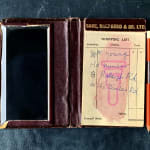-
Artworks
Nettie Edwards
Grave Goods I, 2021Mixed mediaVariousEdition of 1POA“These are her things,’ he was saying.”These are her things! She touched these things, she chose and bought them one by one, she arranged them lovingly and she thought they...“These are her things,’ he was saying.”These are her things! She touched these things, she chose and bought them one by one, she arranged them lovingly and she thought they were beautiful. Oh my mother, my poor foolish little mother!’ The tears were streaming down his face. — The Book of Ebenezer Le Page by G.B. Edwards.
In March 2017, my aunt died, leaving a house packed with the accumulation of almost 80 years of a life on this planet, for others to pick over. Eileen was a hoarder and many of her left-behinds were nothing, less than nothing, and yet each till receipt, bus ticket, paper bag and rusty pin meant something to her, or at least, the holding on to them did. Sensing that they might have some yet-to-be discovered relevance in my life, I salvaged as treasures, items that others would trash. For over two years, boxes of “junk” cluttered my studio, filling the air with the unmistakable scent of decay. Why couldn’t I move on?
During the lock-down Summer of 2020, I began to think about using my aunt’s belongings not only as potential photographic subjects but also as equipment and materials with which to make Anthotypes: photographic prints made with plant matter and sunlight. The process is deceptively simple: coloured emulsions are extracted from petals, leaves, fruits or vegetables. A photo transparency is placed on top of emulsion-coated paper, then both are enclosed in a frame and left out in the sun to bleach the exposed areas, resulting in a print. A patient and philosophical approach is required as this process is anything but instant: depending on the weather, exposure times can range from a few hours to several months. In the course of making Grave Goods, I repurposed paperweights and holiday souvenirs as contact frames, clothes pegs as bulldog clips. Paper bags or three dimensional objects such as stockings, suspender clips, needles, pins and coins were used in place of photo transparencies. Shop till receipts, bus tickets, notebook pages, letters from the DHSS, envelopes and birthday cards became printing substrates. A bottle of 1970s Avon Moonwind perfume was used in place of alcohol to facilitate plant pigment extraction. Gift-boxed, monogrammed handkerchiefs became my emulsion straining cloths.
Anthotypes are created through an unstoppable process of decomposition, presenting the capturing of light at its tipping point. Destined to fade, even if left in the dark, these prints are both artefact and ecofact (an organic object subject to decay). This challenges the general perception of photographs as memory-holders, an idea generated through the emotive marketing of vernacular photography, that has engaged chemically coated pieces of paper as passive collaborators in a conspiracy of emotional co-dependency. My work seeks to present photography not as an act of preserving memories but a performative one of letting go.
1of 3

